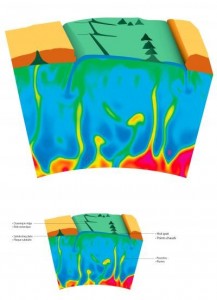Scientists have used X-rays to expose the extreme conditions in the Earth’s core that lead to volcanoes, offering observational evidence that volcanic hot spots are indeed caused by giant plumes of magma flowing upward from within the Earth.
Most volcanoes are found where continental tectonic plates push or pull against one another, but volcanic hot spots are formed completely differently because they are found far away from plate boundaries. The chain of Hawaiian islands are thought to originated from a mysterious hot spot beneath the Pacific ocean floor.
Each island in the chain began as an active volcano fed by the hot spot, and as plate tectonics move the burgeoning island away from the hot spot, the volcano becomes extinct. The hot spot will then create another volcano which becomes the next island in the chain.
One theory for the formation of these hot spots suggests mantle plumes – narrow streams of hot rock with mushroom-like heads – push upward from within the Earth, sometimes as far down as 1,800 miles deep. But the existence of mantle plumes is a fiercely debated among geologists.
“We know less about the Earth’s deep mantle than about the surface of Mars,” researcher Denis Andrault, a mineral physicist at Blaise Pascal University, told OurAmazingPlanet.
In the lab, Andrault and colleagues devised a test to see what kind of material stored in the Earth’s core could be hot enough and light enough to rise through thousands of miles of Earth’s mantle and cause hot spots.
They compressed miniscule pieces of rock – no bigger than a speck of dust and ten times thinner than a human hair – between the tips of two conical diamonds, creating more than 1,000 times the pressure found at the bottom of the Mariana Trench, the deepest point in the ocean, reports MSNBC.
Using a laser beam, they heated the samples to over 5,000 degree Fahrenheit, which mimics the conditions at the core-mantle boundary. Beams of X-rays then showed the researchers where the solid rock had melted.
“It is the iron content which is decisive for the density of molten rock at the core-mantle boundary. Its accurate knowledge allowed us to determine that molten rock under these conditions is actually lighter than solid,” Andrault said.
Because the liquid is lighter than solid rock, it rises up, forming the mantle plume and feeding the hot spots. The results of the experiment are also of great significance for the understanding of the early history of the Earth, as they provide an explanation why many chemical elements playing a key role in our daily life gradually accumulated from the Earth’s inside to its thin crust, close to the surface, researchers said.



 August 15th, 2012
August 15th, 2012  Riffin
Riffin 
 Posted in
Posted in  Tags:
Tags: 